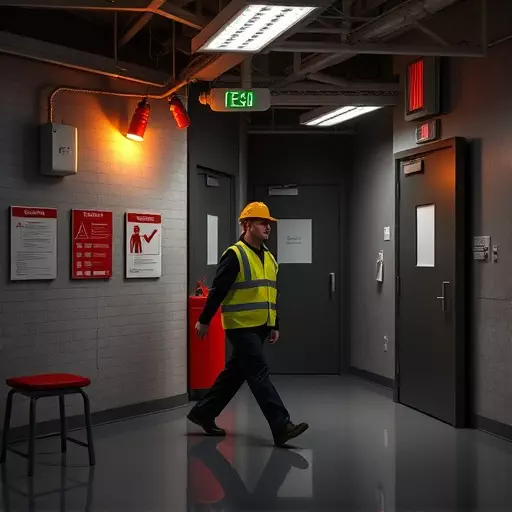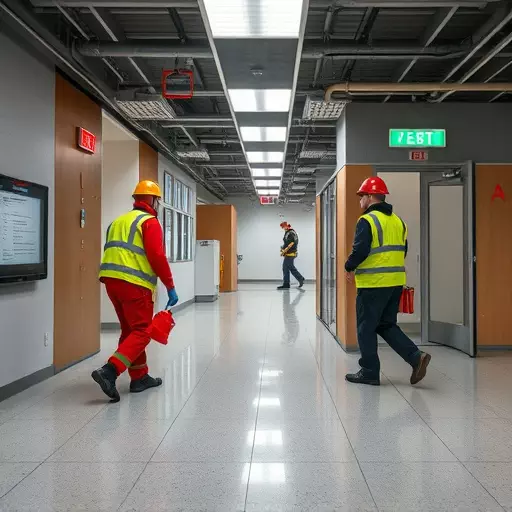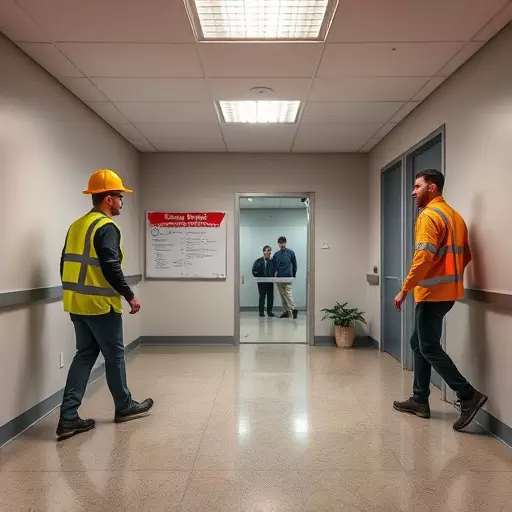Emergency workplace safety training is a multifaceted approach to ensuring employee well-being, encompassing hazard communication, fire safety, and regular drills. This comprehensive strategy equips workers with knowledge about chemical risks, proper labeling, personal protective equipment (PPE), evacuation procedures, fire prevention, detection, and response techniques. Workplace evacuation drills simulate real-life scenarios, fostering preparedness and confidence. Fire safety training focuses on identifying hazards, using extinguishers, and following evacuation routes. Regular updates to these programs maintain a culture of readiness, as seen through interactive technologies and immersive simulations that enhance knowledge retention. Continuous risk assessments and post-drill debriefings ensure the hazard communication program remains effective and aligned with industry standards, ultimately strengthening workplace safety.
“Enhance your organization’s safety posture with comprehensive hazard communication training—a vital component of emergency workplace safety. This article provides a detailed guide, exploring key aspects from understanding the basics to implementing effective strategies. We delve into essential topics such as fire safety training, workplace evacuation drills, and industry-specific hazards. By combining theoretical knowledge with practical techniques, including visual aids and simulations, you can create a robust hazard communication program that fosters a culture of safety.”
- Understanding Hazard Communication Training: A Comprehensive Overview
- The Importance of Emergency Workplace Safety Training
- Components of Effective Fire Safety Training
- Implementing Workplace Evacuation Drills: Strategies and Best Practices
- Creating a Safe Environment: Hazcom Training for Different Industries
- Utilizing Visual Aids and Simulations in Hazard Communication
- Continuous Improvement: Evaluating and Updating Your Hazcom Program
Understanding Hazard Communication Training: A Comprehensive Overview

Hazard communication training is an essential component of comprehensive emergency workplace safety training. It equips employees with critical knowledge and skills to identify, assess, and mitigate risks in their work environment. This includes understanding chemical hazards through proper labeling, safety data sheets (SDS), and personal protective equipment (PPE). By participating in regular workplace evacuation drills, staff members learn effective evacuation procedures, assembly points, and emergency contact information.
Fire safety training is another vital aspect of hazard communication, focusing on prevention, detection, and response strategies for fires. Employees are taught about fire hazards specific to their work areas, the proper use of extinguishers, and evacuation routes during simulated scenarios. Regular refreshers and updates ensure that everyone remains prepared and aware, fostering a culture of proactive workplace safety.
The Importance of Emergency Workplace Safety Training

Emergency workplace safety training is an indispensable component of any organization’s commitment to its employees’ well-being. It equips workers with crucial knowledge and skills, enabling them to respond swiftly and effectively during emergencies like fires, natural disasters, or chemical spills. Regularly conducting workplace evacuation drills, a key aspect of this training, ensures that everyone understands their role in keeping the facility safe.
Fire safety training, another vital component, teaches employees about potential hazards, proper usage of fire extinguishers, and evacuation routes. By consistently updating these training programs, organizations can create a culture of preparedness, minimizing panic and maximizing survival rates during unexpected events.
Components of Effective Fire Safety Training

Effective fire safety training is multifaceted and crucial for ensuring emergency workplace safety. Firstly, it involves educating employees about potential fire hazards within the workplace, such as identifying sources of ignition or combustible materials. This knowledge empowers them to proactively mitigate risks. Secondly, comprehensive training includes regular workplace evacuation drills that simulate real-life scenarios. These drills help individuals familiarize themselves with evacuation routes, assembly points, and the use of firefighting equipment like extinguishers.
Additionally, fire safety training should cover proper response procedures during an emergency. This includes instructions on how to sound alarms, notify others, and evacuate safely. Employees must also be taught basic first aid and cardiopulmonary resuscitation (CPR) techniques to provide immediate assistance until professional help arrives. Regular refresher courses and updates on changing safety protocols are essential to keeping everyone prepared and confident in their ability to handle fire-related situations effectively.
Implementing Workplace Evacuation Drills: Strategies and Best Practices

Implementing workplace evacuation drills is a vital component of comprehensive emergency workplace safety training. These exercises serve as a practical simulation of real-world scenarios, helping employees understand their roles and responsibilities during an emergency. Regularly scheduled drills, conducted in accordance with best practices, ensure that everyone is prepared and aware of evacuation routes, assembly points, and communication protocols.
Strategic planning is key to successful workplace evacuation drills. Organizations should identify potential hazards specific to their facilities, such as fires, chemical spills, or natural disasters. Customizing drills to align with these risks enhances their effectiveness. Involving employees in the planning process fosters a sense of ownership and engagement, encouraging active participation. Additionally, conducting drills at different times of the day or week can reveal unexpected challenges and improve overall preparedness.
Creating a Safe Environment: Hazcom Training for Different Industries

Creating a safe environment is at the heart of effective hazard communication (Hazcom) training. This is especially crucial in diverse industrial settings where workers regularly encounter various risks, from toxic chemicals to fire hazards. Customized Hazcom programs are essential to ensure every employee understands the potential dangers and knows exactly what to do in case of an emergency. These programs go beyond simply distributing safety data sheets; they involve interactive workshops, practical demonstrations, and regular workplace evacuation drills that prepare personnel for real-life scenarios.
Industries such as manufacturing, healthcare, and construction require tailored Hazcom training due to their unique challenges. For example, fire safety training is vital in manufacturing plants with complex machinery and large amounts of combustible materials. Regular exercises simulate different fire scenarios, teaching employees the proper response, evacuation routes, and the use of fire extinguishers. In healthcare settings, Hazcom focuses on infectious diseases, handling hazardous substances, and emergency workplace safety training to protect both patients and staff. These industry-specific programs not only comply with regulatory standards but also foster a culture of proactive safety awareness.
Utilizing Visual Aids and Simulations in Hazard Communication

Incorporating visual aids and simulations is a powerful method to enhance emergency workplace safety training. These tools can effectively convey complex hazard communication, making it more accessible and memorable for employees. During workplace evacuation drills, for instance, using realistic scenarios projected on screens or virtual reality headsets allows trainees to experience potential hazards without actual risk. This immersive approach encourages active participation and improves retention of critical safety protocols.
Simulations also play a pivotal role in fire safety training. They can depict various fire scenarios, enabling employees to familiarize themselves with evacuation routes, meeting points, and the use of firefighting equipment. Visual aids such as digital displays or 3D models can showcase the behavior of flames, smoke, and heat, providing a comprehensive understanding of fire dynamics. Such interactive experiences not only bolster knowledge but also foster a sense of preparedness among workers, ensuring they are well-equipped to respond calmly and efficiently during actual emergencies.
Continuous Improvement: Evaluating and Updating Your Hazcom Program

Regularly evaluating and updating your hazard communication program is a cornerstone of maintaining a safe and compliant workplace. Continuous improvement ensures that your emergency workplace safety training remains relevant and effective, aligning with evolving industry standards and best practices. Conducting periodic risk assessments helps identify new or changing hazards, requiring adjustments to existing safety protocols. For instance, incorporating more comprehensive fire safety training could be necessary if your facility introduces new equipment or processes that pose heightened flame or smoke risks.
Workplace evacuation drills play a pivotal role in this process. By simulating real-world scenarios, these drills allow employees to practice safe evacuations and help identify weaknesses in your current plan. Post-drill debriefings provide an opportunity to discuss findings, update procedures as needed, and reinforce the importance of individual responsibility during emergencies. This dynamic approach ensures that your hazcom program grows stronger over time, fostering a culture of proactive workplace safety through regular evaluation and adaptation.


